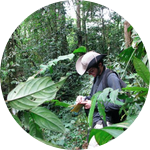About This Project
What's so great about being a juvenile monkey? Capuchin monkeys spend a much longer time than they should as juveniles, a life-stage where the animal is in limbo between weaning and complete maturity. By focusing on how rapidly (or slowly) juvenile white-faced capuchins acquire the skills they will need as adults, I hope to better understand the pressures that have led to the evolution of an extended juvenile period in this species.Ask the Scientists
Join The DiscussionWhat is the context of this research?
- White-faced capuchins (Cebus capucinus) and their close relatives are oddballs among the New World monkeys for the long periods of their lives they spend as juveniles, a time after complete weaning but before full sexual maturity. Seen from an evolutionary perspective, such a delay in sexual maturity must be accompanied by some benefit later in life, and one such benefit may lie in learning necessary foraging behaviors.
- Capuchins stand out among New World monkeys for their use of tools and their dexterous, extractive foraging techniques (1). Thus, these monkeys are able to locate and exploit foods that are inaccessible to other animals in the same habitats.
- Despite the impressive complexity of these animals' foraging repertoire, little is known of how these animals acquire these skills.
What is the significance of this project?
Prior studies would indicate that juveniles of this species attain adult-like foraging skills early in juvenility, while other primate taxa show developmental sequences or trends in such skills. More specifically, developmental trends for the consumption of palm nuts have been observed in a closely related species of monkeys, yet this question remains unaddressed in my study species (see 2). If funded, my study will address this gap in our knowledge, contributing to our understanding of developmental trends in foraging skills – an area that is poorly understood with regard to capuchins. This knowledge is essential in discussions of the evolution of an extended juvenile period, a trait that distinguishes capuchins, as well as humans and the great apes, among primates.
What are the goals of the project?
- Quantify the efficiencies with which different age groups of white-faced capuchins forage on various foods.
- Observe other aspects of foraging behavior in these age groups.
- Compare and contrast feeding/foraging behaviors among age groups.
- Contribute to a larger discussion about the evolution of extended juvenile periods in primates.
Budget
In order to even carry out my project I need to live in Costa Rica for nearly two months, and I need airfare to get to and from this country. Once I'm in the country, I have to get to my field site on the Osa Peninsula, and this means bus rides and connecting flights!
Additionally, since these monkeys are extremely hyperactive, I'll need voice-activated audio recorders so that I don't miss a thing when I'm recording my data.
While I'm away in the field, my wife and I still owe rent on our house back in Kent, Ohio! In total, my share of the rent over the summer will be approaching $700, a fraction of which I've included in this budget.
Once I'm back stateside, the name of the game will be data analysis. While I could certainly do all of this at the office on university computers, I would rather be able to do some of it at home in the company of my wife Caylee and our three cats. To do this, I need a student license for SPSS, a statistical package, for my laptop.
Meet the Team
Team Bio
I hail from the air-force town of Fairborn in southwest Ohio. In my spare time, I enjoy baking bread and other confections, reading good science fiction (as well as nonfiction), and spending the days with my lovely wife Caylee and our three cats, Bleu, Queso, and Isabelle.After receiving my B.A. in anthropology from Ohio University, I taught middle-school science in Wheatley, Arkansas for two years. During this time, I really fell in love with science as a method (and a worldview) while also ending up astounded at the behavior of my young students. So, I figured I would combine these two sentiments and return to school to carry out behavioral research on primates! Now, as a newcomer to the field of primatology, I am focusing on evolutionary questions around why we and our primate relatives are young for so long in the first place.
Morgan E. Chaney
Ever since a young age, I have loved asking questions of causation - I probably annoyed my parents to death with all of the why questions! Growing older, I turned my questions toward my own species as I took on a major of anthropology, concentrating in biological anthropology. The most specific research questions I love to reflect on are about the biological underpinnings of human behavior, specifically with reference to juvenility. Turning a scientific lens to even mundane aspects of human life is an electrifying prospect for me. For example, what social purpose, if any, does playing with others serve humans in the long term? Why do humans especially have such a protracted juvenile and subadult period? The study of primates offers thrillingly interesting insights into these questions and so many more, and I will ideally spend my professional life digging into those queries.
Press and Media
This project was reported by The Post, the student-led newspaper of Ohio University, my alma mater. Click here to see the article.The Ohio University College of Arts & Sciences Forum also showed support for my project by featuring it. I'm thrilled to see so much support from the OU community several years after leaving! Click here to see that article.
Project Backers
- 19Backers
- 150%Funded
- $1,500Total Donations
- $78.95Average Donation
